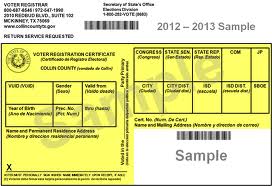Sure it’s nice to see, but a little perspective is in order.
Still the only voter ID anyone should need
In Texas, it’s not just women who are fired up about access to abortion and registering to vote in large numbers following this summer’s historic Supreme Court decision striking down Roe v. Wade.
A new analysis from political data and polling firm TargetSmart found that while Texas’ new voter registrants are evenly split between men and women, they are younger and more Democratic than before the June ruling.
“It’s not that we’re not seeing a surge from women but that in Texas, we’re somewhat uniquely also seeing a surge from men, particularly younger, more progressive men, who are matching the surge from women,” said CEO Tom Bonier, whose firm works with Democratic and progressive candidates.
“I would expect to see that trend develop more in other states as we get closer to the election, but it was interesting to see Texas as first in that sense.”
According to TargetSmart, Democrats now have a 10-percentage point advantage among new registrants since the high court’s decision in Dobbs v. Jackson Women’s Health Organization, making up 42 percent to Republicans’ 32 percent. Prior to Dobbs, Republicans had a five-point advantage.
The state’s young voters — defined as those under age 25 — are also leaning more blue, the analysis found. Democrats now make up 47 percent of young Texas voters, up from 34 percent. The Republican share has remained the same at just under 30 percent.
That’s in line with what TargetSmart is seeing in 25 states that report party registration. In Texas, the firm uses a variety of data, including past primary participation and consumer demographic data, to identify likely Democratic and Republican voters.
Whether the registration trend will translate to high turnout of young voters is still yet to be seen. The group had tended to turn out at low rates compared to other age groups, but that trend started to turn around nationally and in Texas in 2018.
That midterm election year, with the rise in popularity of Democrat Beto O’Rourke amid his campaign for U.S. Senate, turnout among 18- to 29-year-olds more than tripled from about 8 percent in 2014 to about 26 percent.
“No one knows if that’ll be the case in 2022,” Bonier said. “But there is reason to be optimistic that these younger voters are much more highly energized than they have been in past.”
Bonier added that new voter registrants tend to have a higher turnout rate than those already registered.
I believe this story is based on this recent tweet thread from Bonier; there’s a link to an earlier Chron story about voter registration as well. It’s a cardinal rule to me that anytime you see a story about numbers that are solely expressed in percentages, you have to think about what the actual numbers are. Big percentages of small numbers are still small numbers, and vice versa. Here, the main thing we don’t know is how many voter registrations we’re talking about. We won’t have official numbers on that until October, after the registration deadline. Here’s what the registration figures since November of 2020 look like – you can find the state data here:
November 2020 – 15,279,870
January 2021 – 15,757,825
November 2021 – 16,007,280
January 2022 – 16,150,258
March 2022 – 15,944,184
This is a reminder that voter registration does not always go up. As we well know, voters also get removed from the rolls, sometimes for legitimate reasons like death or moving out of state, sometimes not. Whatever the case, we were just under 16 million in March. We’ve probably added a couple hundred thousand since then, so maybe we’re up around 16.2 or 16.3 million or so; I’m just guessing.
Now go back and look at what Tom Bonier said. Before the Dobbs ruling in June, Republican-profiled people were leading the new registrants. We don’t know how far back that goes, my guess is to March but who knows. Point being, we don’t know how many net new presumed Republicans this represents. We also don’t know how many new registrants there have been since June, when Dems showed the advantage. Maybe that’s enough to overcome the earlier deficit. I couldn’t tell you from the information I have available to me.
Let’s just focus on the post-Dobbs voters. Let’s say we get 100K new voters from then until October. If Dems have a ten-point lead in voter registrations during this time, that’s a net 10K potential voters for them. That number will be less than that in the end, as not everyone votes, so maybe it’s a 6K or 7K advantage. Not nothing, to be sure, but very likely not enough to tip any election.
I don’t say all this to be a bummer. It’s great that we’re doing well with voter registration! Keep it coming! I’m just saying it’s not going to magically carry us to victory. There are a lot more pieces to the puzzle than that. Don’t get distracted by the shiny object.

